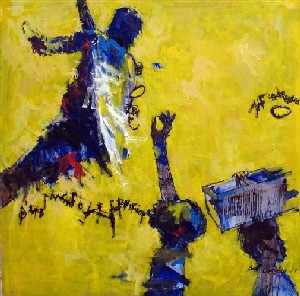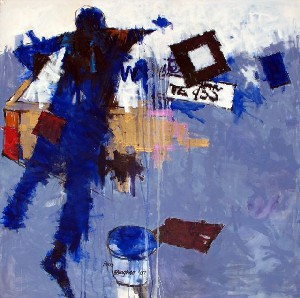In 2007 we organized at the Pan-African University an exhibition of paintings by Ben OSAGHAE and Ogbemi HEYMMAN. I am posting a couple of pics from each of the artists and the write up I prepared for the brochure.
Artists, University and Society
Pan-African University has pursued from its first steps a long-term commitment to support the visual arts and to make them more relevant not only to the academic community but also to the larger society. This University believes artists have an important role to play in the process of creating and disseminating a culture that puts the human person at the centre of history. With the classics, there is an understanding of culture as “cultivation of the person”, an acknowledgement of the pivotal responsibility of the artist in bringing this humanism to society and a conviction that the task ahead of the contemporary Nigerian artist goes far beyond the “decoration” of public and private spaces. Today’s artists are called to inject fresh air in a rarefied environment and to render a true “social service”. Ben Osagahe and Ogbemi Heymann have wholeheartedly accepted this responsibility.
For well over two decades Osaghae has chronicled the adventures and misadventures of his land and his people; he has looked at the immediate social and political reality, mainly in an urban setting. He, like few of his colleagues and contemporaries, has remained attentive to social and cultural developments in his environment; at times as a chronicler, telling us a story; on occasion, as a foreigner, but always attentive to reality. His works borrow from photography: the unexpected angle and the unconventional point of view are reminiscent of the amateur snapshot, rather than of the studio portrait with its artificiality and rigidity.
For Osaghae and Heymman the canvas is a medium between society and the onlooker. Through their works they communicate, they comment on what happens around them. There is always a “narrative” in these works, but not at all linear, unequivocal, direct. We find an ambiguity of meaning that challenges the viewer to interpret images and discover subtle references. They are the artist-seers and the artist-prophets of society.
Osaghae’s works are a forceful account on the human condition as affected by our present historical circumstances. His paintings are chronicles, metaphors and prophecies on social life. There is a subjectivity constantly affirmed through the contingent, precarious character of the works. Precariousness and Fragmentation are central characteristics of his paintings. They are not grandiloquent discourses on central issues of the human person, history and society. Neither are they disclosures of his private, autobiographical history. They are just small glimpses of passing realities. No distinguished personages appear in them, but little stories told with affection and in a very personal way, without the aggressiveness of so much contemporary art. We mention the precariousness in his works and this is shown also in the way he uses the media. He does not aim at academic, formalistic, static perfection in the treatment and representation of the subject of his paintings. Particularly in his most recent works there is a tension between the urge to create and the concern to achieve a “finished” (completed) outcome. In a way we can say that his works appear not by design, but by chance.
A recurrent concern for little realities pervades Osaghae’s and Heymman’s paintings: the works in Faithful Mirrors are not monumental, categorical works of epic character. Not nihilist existentialism, but a joie-de-vivre, a light mood, a pervading affection for the subject. Subjects are depicted with tenderness, with respect. It is clear that these artists look at their subjects with empathy. Though at times there is irony and sadness, we rarely find anger.
Contemporary discourses and influences are clearly present in Osaghae’s works, but he does not go to the extremes of deliberate ugliness found in some expressionist, dada or post-modern artists. A superficial reading of his paintings might suggest that he is not concerned with beauty, balance and harmony, but it could be argued that he is not against beauty, that simply he is against prettiness. Of the three classical “transcendentals”, he puts truth first and, only then, goodness and beauty. He does not want to fall in the trap of sacrificing truth on the altar of attractiveness. He bets everything on the expressive strength of drafting, colouring and a strong narrative. At the same time, his art wants to be “sincere”. His works are not about beauty, but about communication. For him, equipoise, a state of equilibrium, is not the primary concern. If in a painting he thinks contorted human figures, ragged edges, impatient brushstrokes and brash colours help transmit his message more forcefully, he is ready to use them at the expense of any form of “serene” beauty.
Heymman is an artist that clearly enjoys the materiality of painting, the texture of the surfaces, the vibration of the colours, the opacity of the pigments. He paints with sweeping brushstrokes that are fast, firm, painterly and at the same time have great gestural intensity.
All in all, the works in this exhibition are a strong statement dropped in an artistic milieu full of weak and trite works. For this reason, Faithful Mirrors is a significant contribution to the current Nigerian art scene. Pan-African University, by bringing this exhibition to an academic environment makes art a little bit more visible and a great deal more accessible. This will no-doubt benefit students, faculty, staff and the many visitors that will not want to miss this opportunity to see the recent works of two of the most prominent contemporary Nigerian artists.
Jess Castellote




